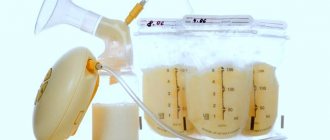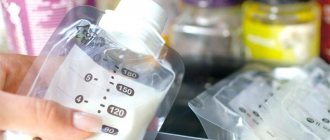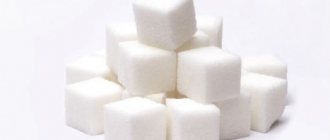Breast milk is considered the best natural food for a newborn. It contains many nutrients that a baby needs during the first months of life. In the second half of the first year, it satisfies the baby’s needs by more than half, and in the second year of life – by one third. Over time, the calorie content of breast milk also decreases (100 ml - 53–80 kcal).
It protects the newborn from chronic and infectious diseases and promotes cognitive and sensory development. In addition, breastfeeding reduces newborn mortality due to childhood diseases such as pneumonia and diarrhea, and also promotes speedy recovery from illnesses. Breastfeeding is beneficial for the well-being and health of the mother and also reduces the likelihood of breast and ovarian cancer.
Compound
Breast milk has an interesting property. Calorie content and its composition changes depending on the needs of the growing baby. Its main components are carbohydrates, proteins and fats. Let's look at them in more detail:
- Squirrels. Breast milk contains 1.03 g of protein per 100 ml. It seems like a little, but this is quite enough for the optimal development of the child. This amount of protein reduces the risk of developing hypertension, obesity and atherosclerosis in subsequent years of life; protective properties appear during puberty. Protein is necessary for the formation of tissues and cells, the synthesis of enzymes, and hormones. It plays a significant role in the development of healthy intestinal microflora and has immunomodulatory properties. In addition, milk contains non-nutritive proteins, for example, lactoferrin, lysozyme, nucleotides, immunoglobulins. They help protect the body from bacteria, viruses and, accordingly, from intestinal, respiratory and other diseases. You should also know that a certain part of the biologically active molecules contained in mother’s breast milk are species-specific. This means that they are only good for your child.
- Fats. Fat content ranges from 4.0–4.3 grams. Breast milk contains a large amount of polyunsaturated fatty acids; they are required for the development of sensory organs, the nervous system, as well as the intellectual development of the baby. In addition, fatty acids enhance protection against infections.
- Carbohydrates. They typically consist of lactose (milk sugar) and oligosaccharides. The carbohydrate content of milk is 6.89 g per 100 ml. Lactose is necessary for the newborn's body. Firstly, it is the basis for galacocerebrosides, which, in turn, are components of the cell walls of body tissues. Secondly, lactose, together with other oligosaccharides, promotes the favorable reproduction of healthy microflora in the intestines, which has a positive effect on digestion processes, the absorption of required vitamins, micro- and macroelements, and also helps in protection against various infections. Mother's milk has a high content of milk sugar, while other types of milk have much lower amounts.
- Vitamins and microelements. Despite the fact that there are large quantities of them in breast milk, they are quickly absorbed by the baby. For example, up to 70% of iron is absorbed, thanks to which children are less likely to suffer from anemia. It also contains potassium, sodium, calcium, magnesium, phosphorus, and zinc.
How does the composition of breast milk change over the months?
Throughout breastfeeding, the composition of milk changes as it adapts to the baby's changing needs. Milk is divided into four types, which correspond to different feeding periods:
- Colostrum. A viscous, white-yellow liquid is formed during pregnancy and is released 3-4 days after birth (5 to 10 ml per day). Colostrum is very high in calories, contains many leukocytes, immunoglobulins, and proteins. It nourishes, protects the newborn from jaundice, and performs a laxative function.
- Transitional milk. It begins to be produced 4-5 days after birth. At this time, milk becomes more abundant, its composition changes: the content of fats, B vitamins, and carbohydrates increases.
- Mature milk. It is released 2-3 weeks after birth. It contains less protein, but more carbohydrates.
- Involutive milk. It is produced in small quantities in the second year of feeding a child. Its composition is similar to colostrum and contains many substances that strengthen children's immune system.
What affects the calorie content of breast milk?
Many mothers who breastfeed their baby believe that the fattier the milk, the better. However, this is not always true. Sometimes fatty milk can cause dysbiosis in a child. Thus, if the newborn is cheerful and active, and is gaining weight quite quickly, then everything is fine with the milk.
And if the newborn is not gaining weight well or asks to eat very often, then you should think about the quality of the milk. What determines the calorie content of breast milk? Young mothers are interested in this question. There is an opinion that if you eat a lot, the milk will become fatter. This is not entirely true, the fact is that not all food, especially fatty foods, leads to a change in the composition of milk. To increase its nutritional value and fat content, mother should not overeat. Still, she should pay attention to her diet and lactation process.
How to improve the composition of milk?
The nutrition of a nursing woman is reflected in the composition of the milk. If a woman does not receive sufficient micronutrients that are necessary for the normal development of the child, the baby will not receive them, or will receive them, but at the expense of serious health problems in the mother.
For example, a child needs a lot of iron because his blood volume increases with age. If a woman develops iron deficiency during pregnancy and does not receive it from food, then during breastfeeding the lack of iron will only worsen, since iron from the body of the expectant mother will “leave” into milk.
The Pregnoton Mama complex, which contains 15 minerals and vitamins (including iron, iodine, selenium), as well as Omega-3, will help prevent a lack of micronutrients in a nursing mother and child.
What happens?
The calorie content of human breast milk is variable. Primary milk changes step by step into mature milk; color, composition and fat content also change. In the first hours after birth, the baby receives colostrum, which is very high in calories. After two to three days, the newborn is fed low-fat, transparent transitional milk. The benefit lies in the fact that it contains rare nutritional and protective elements that are so necessary for a baby who has just been born. Despite the low fat content of milk, additional fat is not required, since the baby’s body is not yet accustomed to new living conditions, and excess fat will only provoke colic and other unpleasant stomach disorders. The protein content in colostrum is 11–15%, which is three times more than in the mature milk of a woman who is breastfeeding.
Even in small portions all the necessary elements are present. Colostrum contains a small amount of water, which, in turn, reduces the pressure on the still fragile kidneys. After about five to six days, a change in composition occurs in breast milk. The content of carbohydrates and fats increases, and the amount of proteins decreases. This change has a beneficial effect on the baby’s health, and he also receives all the necessary substances. As breast milk progresses to the next stage, it becomes lighter in color as its water content increases. The calorie content of breast milk is about seven hundred calories per liter. This is quite enough for the proper development of the baby. With an increase in fat content, problems such as constipation or colic may appear. It must be remembered that the quality of mother's milk does not depend on percentages, but on its constituent components, so the more useful elements are present in it, the better for the child.
PROTEIN
The protein content of mature breast milk is approximately 1%. This is significantly lower than in the milk of other mammals. Proteins are represented by casein and whey fractions. Casein protein is synthesized directly in the mammary gland, and whey protein is filtered from the mother's blood. The ratio of these fractions in human milk is 20: 80 (30: 70), in cow's milk, on the contrary, the majority is represented by caseins 80: 20. During the digestion process, casein under the influence of gastric juice forms larger flakes than whey proteins and is therefore more difficult to absorb. Breast milk forms almost invisible flakes in the stomach, facilitating digestion and is quickly evacuated from the stomach. This makes it possible to frequently put the baby to the breast without fear of gastrointestinal overload and digestive disorders.
Whey proteins in human milk are mainly represented by alpha-lactoglobulin, an important component of the enzyme system in the synthesis of lactose. It should be noted that breast milk substitutes are made from cow's (goat's) milk and contain beta-lactoglobulin, which is a powerful allergen, as whey protein.
In human milk, a higher level of free amino acids is determined, among which the most important are cysteine and taurine, since their synthesis in young children is difficult. Cysteine is essential for the fetus and children born prematurely, and taurine is necessary for the maturation and development of the central nervous system, as it serves as a neurotransmitter and neuromodulator.
When is it necessary to increase the fat content of milk?
Before increasing the fat content of breast milk, make sure it is really necessary. To do this, you need to analyze breast milk for calorie or fat content. You will need to purchase a regular test tube, which can be purchased at any pharmacy. 15–20 minutes after feeding the baby, you need to express the milk into a test tube. The liquid should fill the vessel by 10 cm. Next, leave the test tube at room temperature for six hours. During this time, the milk will be divided into several parts, the top one is the fattest, and this is what you will need to measure using a ruler. Centimeters are equal to percentages. But do not forget that such calculations are approximate. The average fat content of human breast milk is 4–4.5%.
FATS
In human milk, fats are found in the form of microscopic globules, much smaller in size than in cow's milk. This is the most variable component, since the fat content ranges from 2% (in colostrum) to 4 - 4.5% (in mature milk). Interestingly, the concentration of fat in hind milk is 4 to 5 times higher than in fore milk and this acts as a satiety regulator. Therefore, the duration of feeding should not be regulated and may vary depending on the condition of the child. If the baby only feels thirsty, he satisfies it within 5-10 minutes with foremilk, which is poor in fat, and stops sucking, and, conversely, with a strong feeling of hunger, he can spend up to 1-1.5 hours at the breast. WHO studies have proven that children themselves regulate their energy saturation, but the mechanisms of this have not been clarified.
The fatty acids that make up breast milk are relatively stable in composition and are represented by 57% unsaturated and 42% saturated fatty acids. Long-chain polyunsaturated fatty acids are essential for myelination and maturation of the central nervous system, among which the most important are arachidonic and linolenic fatty acids. Their content in human milk is almost 4 times higher than in cow's milk. The presence of these fatty acids determines the synthesis of prostaglandins in the child’s gastrointestinal tract, which affect many functions that activate digestion and maturation of intestinal cells and thus the entire protective mechanism. Breast milk is rich in prostaglandins, while milk substitutes have none at all.
The main source of energy for the fetus is glucose, and for the newborn and infant - fats. They provide 35 - 50% of the daily energy requirement. Interestingly, only human milk and the milk of some primates contain enzymes that digest fat.
Diet for women who are breastfeeding
Numerous studies have shown that fat content of foods does not affect the composition of breast milk. If a child is sick a lot and grows slowly, then most likely he lacks vitamins. In order for milk to be of high quality, it is necessary to follow simple rules in sufficient quantity. In addition to proper nutrition, it is necessary to massage the breasts and feed the baby often, all this will improve lactation.
Thus, a woman who is breastfeeding should monitor the correctness of her diet in order to maintain the calorie content of breast milk at a certain level. A few simple rules for nutritious and healthy milk:
- It is recommended to eat before each feeding, but under no circumstances overeat.
- A nursing woman's menu should consist of carbohydrates. First of all, these are fruits and vegetables, as well as cereals. About twenty percent are proteins, for example, veal, fish, beef. And fats - a maximum of thirty percent.
- It is recommended to drink plenty of fluids, especially after feeding. It is advisable to drink green, white tea or plain boiled water. After a month, you can add natural juices to your diet (apple juices are best). Black tea can be drunk only after the baby reaches three months of age.
- It is recommended to avoid stress, sleep at least seven hours a day and get plenty of rest.
- To improve lactation, you should massage your breasts every day in a circular motion.
Composition of breast milk after a year of feeding
There is an opinion that prolonged breastfeeding is harmful to the baby. However, research results indicate the opposite: scientists have found that children 1.5–2 years old, whose mothers continue to breastfeed, get sick less often, tolerate illness more easily and recover faster than their peers who grow up on baby food. This is explained by the peculiarities of the composition of breast milk after a year of feeding: it contains a lot of immunoglobulins that protect the child’s body from diseases. Also during this period, the content of substances in breast milk increases that contribute to the development of the children's gastrointestinal tract.
Increase in fat content of milk
Many people wonder how to increase the calorie content of breast milk? To do this, you need to add foods such as:
- tea with milk;
- butter;
- cottage cheese;
- liver;
- hard cheeses with high fat content;
- nuts;
- seeds.
It should be remembered that if a child has allergies, then these products should not be consumed. If a nursing mother decides to introduce new foods into her diet, it is recommended to first try a small portion before lunch. Next, you should monitor the baby’s condition for two days. If everything is in order and there is no negative reaction, then you can eat new foods in small portions. How to increase the calorie content of breast milk using the products listed above? Doctors advise introducing them into the diet no earlier than three months after the birth of the child. Before each new product, you must maintain a three-day pause in order to accurately determine the child’s reaction. It is important to remember dosages. After all, literally a handful of walnuts is enough to increase the fat and calorie content of milk.
The benefits of human milk
Important benefits of breast milk include:
- sterility;
- balanced amount of nutrients;
- milk contains a large amount of biologically protective substances;
- optimal temperature;
- good digestibility of nutrients in the baby’s body with low energy costs;
- beneficial effect on intestinal microflora.
The milk produced at the beginning of feeding is called foremilk. It has a bluish tint, is produced in fairly large quantities and provides the newborn with all the necessary nutrients. The milk that is produced at the end of feeding is called hind milk. The calorie content of front and rear breast milk is different. So, the back contains three to four times more fat and calories than the front.
IMMUNE FACTORS
Mother's milk has a dual effect on the child's body. On the one hand, it itself has protective properties, on the other hand, it stimulates the development of the baby’s own immune system.
Immediately after birth, a huge number of microorganisms, the toxins they produce, and allergens enter the baby’s body. It is difficult to imagine how the still immature immune system of a newborn would cope with such an attack if not for mother’s milk. Human milk, and especially colostrum, contains a huge number of protective factors such as immunoglobulins of class A, M, G, lysozyme and other enzymes, lactoferrin, bifidus factor, macrophages, lymphocytes, neutrophils, epithelial cells. Immunoglobulins, especially secretory immunoglobulin A, envelop the baby’s gastrointestinal tract and prevent pathogens from entering it. At the same time, the maturation of the intestinal epithelium and the production of digestive enzymes are stimulated.
The mother’s body is constantly in the process of producing antibodies against bacteria and viruses that enter her body. These antibodies pass into milk and protect the baby against many pathogens. Fragments of viruses also enter breast milk, stimulating the baby’s body’s sensitivity to them, resulting in effective immunization.
Interesting facts about breast milk
Here are some of them:
- Human breast milk (the calorie content of which was indicated above) contains immune cells that provide protection against a large number of different infections.
- Milk contains hormones and growth factors. They affect metabolism. As a result, at an older age, the child is less susceptible to the occurrence of metabolic diseases such as atherosclerosis, obesity and hypertension, as well as cancer and many others.
- The calorie content of breast milk per 100 grams is 70 kcal.
- Carbohydrates, proteins and fats are easily absorbed by a newborn, since mother’s milk contains special digestive enzymes, with the help of which the baby’s intestines easily break down nutrients.
- Breast milk contains several dozen different bifidobacteria, which are necessary for the formation of immunity and the fight against inflammation and infections.
- 87% of breast milk is water. It is active and quickly absorbed, so the newborn does not require special supplementation.
Mother's milk is a unique nutritional substrate that helps the baby develop and grow harmoniously. Forms intelligence, develops immunity and sets the level of health for the rest of life.
Dairy components
Water. GM is 80% water, so when the mother thinks the baby is thirsty, she can give GM. This will quench thirst, protect the child from infection by pathogenic agents and allow him to develop well.
Squirrels. In GM they are of two types - whey protein, which is approximately 60%, and 40% casein. This ratio allows for quick and easy absorption of GM. The higher casein content in some adapted dairy products may make them more difficult for your baby to digest.
About 60-80% of the total protein in breast milk is whey protein. But it also contains other specific elements such as:
Lactoferrin
It inhibits the growth of iron-dependent bacteria in the gastrointestinal tract. This stimulates the proliferation of certain gastrointestinal organisms (such as coliforms and yeast) that require iron for their development.
Immunoglobulin A (IgA)
Helps protect against viral and bacterial infections and possible allergies. In addition to this immunoglobulin, GM also contains others (IgG and IgM) that also have an anti-infective effect. To increase the amount of immunoglobulins in the GM, mothers are advised to eat fish more often.
Fats
GM also contains fats that are essential for baby's health. They are a major basal source of calories and are beneficial for brain development and the absorption of fat-soluble vitamins. Children's nerve cells are covered with a substance called myelin, which helps transmit messages to other nerve cells in the brain and body. To produce high-quality myelin, you need some types of fatty acids - linoleic and linolenic, which are present in the required quantities in GM. Typically, the level of fat at the beginning of the diet is low and then increases. The amount of fat in GM is constantly changing. Longer intervals between meals lead to a decrease in the presence of fat in the GM, which is one of the reasons that a strict 3-4 hour diet is biologically incorrect.
Vitamins and minerals
The amount and type of vitamins and minerals in the GM are directly related to the mother's nutrition. Therefore, it is extremely important that she eats properly and takes the required amount of healthy food, both during pregnancy and lactation. In this regard, advice from doctors and lactation consultants will also be needed. Fat-soluble (A, D, E and K) and water-soluble (C, riboflavin, niacin and pantothenic acid) vitamins are vital to children's health.
Carbohydrates
Lactose is the main carbohydrate in GM. It accounts for approximately 40% of the total calories provided by it. This helps reduce the number of harmful bacteria in the stomach (which improves the absorption of calcium, phosphorus and magnesium), stimulates the formation of beneficial bacteria and fights disease. However, some children have significant problems with lactose tolerance.
Composition of some essential nutritional components present in GM.
What else is in breast milk?
GM also contains important non-nutritional components - antimicrobial factors, digestive enzymes, hormones and growth factors that are important for passive defense against infections and immune-mediated diseases, as well as those that modulate the development of the immune system.
Lysozyme
An enzyme that promotes the growth of intestinal flora, has anti-inflammatory functions and protects the baby from bacteria such as E. coli and salmonella.
Bifidus factor
Promotes the growth of lactobacilli (Lactobacillus). This is a group of beneficial bacteria that protect children from harmful bacteria by creating an acidic environment in which they cannot survive.
Every year, medical publications demonstrate the discovery of new important substances and properties contained in GM. Experts are only at the beginning of studying other GM factors that are potentially important for the maturation of the baby. In particular:
- - enzymes other than lipase;
- — epidermal growth factor is present in GM in significant quantities, promoting the development of gastrointestinal tissues and other areas;
- - hormones in the GM that affect the metabolism, growth and physiology of a small person.
The influences can be both short-term and long-term. Science is at the beginning of research, and we will soon find out what other advantages GM has. At the moment, it is known that with breastfeeding, a child receives more than 700 types of bacteria, GM improves the effect on the DNA of children and strengthens their immunity, scientists have also already shown that GM contains stem cells, which are extremely important for children, especially when their immunity is weaker.
Stem cells
Stem cells were first discovered in breast milk in 2007. The results, presented at the National Breastfeeding Symposium in London in October 2014, show that stem cells in breast milk do play a role in the development of many organs, including the brain, pancreas, liver, spleen and kidneys. Many of them integrate into the body and become functional cells.
Breast milk should be the main source of calories by the end of the first year of life (this means about 75% milk and 25% solids). Iron requirements increase after the first 6–9 months, so it is beneficial to include iron-rich foods in the second half of the first year.
How to increase the calorie content of breast milk?
First of all, you need to pay attention to your diet. Mothers who are breastfeeding should create a special menu. You cannot go on a diet; food must be complete and varied, contain vitamins and microelements that are required to maintain the health of mother and baby. As a result of the interaction of the organs of the circulatory system and lymph, breast milk is formed. The diet of a woman who is breastfeeding must consist of 20% proteins, 30% fats and 50% vegetables, fruits and cereals. Calcium is considered one of the most important microelements. It is present in milk, cottage cheese, fish, cabbage. Its deficiency will affect the woman’s nails and hair, as the child will take as much as he needs. The mother's food intake should be compared with the needs of the newborn; if he eats seven to eight times a day, then the mother should eat the same amount, but in small portions.
At first it will be quite difficult to change your mind, but gradually it will become a habit. Soups and cereals are required in the diet of a nursing mother. You should be careful with rice, as it can cause constipation in your baby. It is best to cook porridge with milk. For soups, it is recommended to use lean meat, such as turkey, chicken or beef. Fresh greens contain a large amount of vitamins and microelements that are required for health.
How to increase the calorie content of breast milk? Foods such as broccoli and walnuts increase the fat content of milk, but they should be consumed in small portions so as not to cause allergies in the baby. You can also make a milk drink from them. Add two tablespoons of nuts to 200 ml of boiling milk, then let it brew for about half an hour. It is advisable to drink the drink every day, 1/3 glass three times a day.
Nutrition plays a major role in the feeding process. However, just a balanced diet is not enough; proper rest and daily walks in the fresh air are necessary. In addition, it is necessary to exclude stress and increased physical activity. An excellent mood and positive emotions play a big role, since the mother’s well-being is reflected in the baby.
BREAST-FEEDING
Breast milk is an ideal food product for children in the first year of life. Early artificial feeding is known to be a risk factor for the development of nutrition-dependent conditions in young children, such as rickets, iron deficiency anemia, hypovitaminosis; later diseases - obesity, type 2 diabetes mellitus in adolescents, atherosclerosis. Thus, preparing a woman during pregnancy for lactation, a favorable course of labor, proper nutrition of a woman during lactation, psychological comfort - all this will help maintain the ability to lactation and protect the unborn child’s body from diseases.
What determines the quality and quantity of breast milk?
The composition of breast milk is primarily related to the timing of lactation. In the first 2-3 days after birth, when a newborn baby can suck very little milk from the breast, the mother produces so-called colostrum, which has a very high nutritional value.
Colostrum has a high content of minerals and, most importantly, protective factors, in particular secretory immunoglobulin A, which protects the child’s intestines from infections. Colostrum absorption approaches 100%
After 4-5 days, the mother produces transitional milk with less protein and minerals, but with a higher fat content. At the same time, the amount of milk produced also increases, which corresponds to the child’s ability to absorb large volumes of food. Gradually, the composition of breast milk stabilizes: at 2-3 weeks after birth, mature milk is produced, which on average contains 1.2% protein, 3.5% fat and 6.5% carbohydrates. However, it should be remembered that the quality and quantity of breast milk depends on the nature of the woman’s diet during pregnancy. During this period, depending on the mother’s diet and regimen, the composition of breast milk may change slightly.
The composition of your breast milk depends on your diet!
Limit your consumption of coffee or tea, as caffeine is found in milk. Don't drink alcohol and don't smoke! Do not take any medications without first consulting your doctor, as they can pass through breast milk into your baby's body.
Remember to drink plenty of fluids. Your water needs are increased because during lactation milk consists mostly of water (75% of its composition). You need to drink about 2-3 liters of liquid per day (water, fruit juices, tea and soup).
Benefits of breastfeeding:
- Breast milk is a fresh, sterile, optimal temperature, ready-to-use product for the baby.
- The optimal composition of breast milk best satisfies the needs of a growing body for proteins, fats, carbohydrates, vitamins, microelements, and therefore the child does not need the introduction of additional food products (complementary foods) until the 4-6th month of life.
- Due to its balanced composition and the presence of special enzymes in breast milk that are involved in the process of digestion and absorption, feeding it is not accompanied by any digestive disorders.
- Breast milk helps populate the baby’s intestines with “useful” microorganisms, preventing the proliferation of pathogenic bacteria, ensuring the prevention of intestinal dysbiosis.
- Breastfeeding reduces the risk of developing allergic diseases and chronic digestive diseases.
- It is known that children fed with breast milk are less likely to suffer from intestinal and acute respiratory infections, due to the fact that milk contains protective factors - maternal antibodies, macrophages, lymphocytes.
- Human milk contains factors that protect the child from malignant tumors, cardiovascular diseases, and reduce the risk of developing sudden death syndrome.
- It is known that children who are breastfed for a long time are subsequently less likely to be susceptible to hypertension, atherosclerosis, and diabetes.
- Human milk is rich in taurine (an amino acid), unsaturated fatty acids that ensure the development of brain tissue and the formation of normal intelligence in the child.
- It has been noticed that breastfed children are more friendly, friendly, sociable, and have closer contact with their mother. Breastfeeding also has a positive effect on the mother's health, reducing the risk of developing mastitis, breast and ovarian cancer.
- Regular breastfeeding is a natural method of contraception
How to breastfeed your baby correctly?
Position of mother and child:
- Mother's pose (sitting on a chair, lying in bed) - the woman is comfortable, she is relaxed.
- The baby's body is pressed against the mother, face to the chest.
- The baby's head and body are located in the same plane.
- The baby's chin touches the chest.
Does emotional background affect feeding?
- Affects. The mother should not be distracted by anything; her attention is focused only on the child.
- It is recommended to turn on calm music.
- Close contact with the child: “skin to skin”, “eye to eye”.
The correct reaction of a child during feeding:
- The mouth is wide open, the lower lip is turned outward.
- The child grasps not only the nipple, but also the entire areola.
- The tongue is curved into a tube around the nipple.
- The cheeks are rounded, not retracted.
- The baby is calm and focused on the chest.
- Sucking with pauses.
- Duration of sucking 15-20 minutes
- When the baby is full, he releases the breast on his own.
Problems that women may experience while breastfeeding:
- Feeling of distension, fullness of the mammary gland
This is usually due to the fact that the mother has a lot of milk. At the same time, the woman’s well-being and body temperature are normal. The chest feels hard, tight and hot. When expressing, milk flows well from the breast.
- Painful engorgement of the mammary glands (lactostasis)
This condition occurs quite often, especially in the first month of feeding a newborn. The main reasons may be: late latching to the breast in the maternity hospital, infrequent latching to the breast, limited time the baby stays at the breast. The woman notes uniform engorgement of the mammary glands, soreness, which is accompanied by an increase in body temperature to 38-38.5C. General health, as a rule, does not suffer.
For lactostasis it is recommended:
- More frequent latching of the baby to the breast;
- In order for the baby to latch onto the breast correctly, express a small amount of milk, this will soften the breast;
- During feeding, massage - stroking the breast towards the nipple;
- After feeding, express milk until the breasts are “soft”;
- Mothers - rest, relax;
- Place a warm compress on your chest;
- Then put on a properly selected bra.
If these measures do not produce a positive effect, then you need to consult a doctor and undergo a course of treatment with drug therapy.
- Cracks and inflammation of the nipples
The main cause of cracked and inflamed nipples is improper attachment of the baby to the breast. First of all, it is necessary to eliminate this cause.
Women who have cracked nipples are advised to:
- Hold the baby at the breast for no more than 7 minutes.
- Follow proper feeding technique.
- Wash your breasts no more than once a day, without using soap, otherwise the protective fatty film is removed from the skin, which contributes to the formation of cracks.
- Flat or inverted nipples
In this situation, the main thing is patience and perseverance. It must be remembered that the baby sucks on the breast, not the nipple. As a rule, already 1-2 weeks after birth, the breast changes its shape, becomes softer, and the nipple becomes more extensible. You can use plastic nipple formers that are placed in your bra. Stimulating the nipples with your fingers before feeding sometimes helps.
If necessary, milk can be expressed for 1-2 weeks and given to the baby from a spoon or expressed directly into the baby's mouth.
What is hypogalactia?
Hypogalactia is a decrease in breast milk production during the lactation period.
Causes of hypogalactia:
Hypogalactia is most often caused by the unreasonable introduction of an artificial formula in the form of “supplementary feeding”. It must be remembered that during the lactation period, as a rule, lactation crises occur, most often on the 20-30th day and in the 3rd month. The simplest method of increasing milk production in this case is to put the baby to the breast more often and provide adequate nutrition to the mother.
Prevention of hypogalactia during pregnancy:
- Psychological preparation of the expectant mother for breastfeeding.
- Preparing the breast for lactation:
- the right bra
- wet wiping of the mammary glands daily
- daily air baths for 10 minutes
- Breast massage is carried out 2 times a day - in the morning and in the evening, the duration of the massage is no more than 3 minutes
When a baby doesn't have enough milk:
- If a child urinates less than 6 times a day and his urine is concentrated - yellow, with a pungent odor.
- After feeding, it is not possible to express milk.
- The child is restless and cries often.
- Small weight gain per month (average monthly weight gain in the first 3 months of life is 800 g).
Carry out control weighing (before and after feeding) during the day, thereby determining the daily volume of lactation.
How to increase milk production:
- Feeding the baby on demand - it is recommended to put him to the breast in case of any anxiety or crying. In the first days of a baby’s life, it is advisable to put him to the breast every hour.
- Mandatory night feedings.
- Offer both breasts at one feeding and finish feeding with the breast you started with.
- Constant physical contact between mother and baby perfectly stimulates lactation.
- Psychological comfort in the family, help and support from the husband and relatives in caring for the baby.
- Adequate night and daytime sleep for the mother.
- Hot shower, bath, breast massage for 3 minutes 2 times a day, back and neck massage.
- Rational and balanced nutrition using vitamin and mineral complexes. The daily drinking volume of liquid should be 1.5-2 liters. Vitamin and mineral complexes should be taken every day in the morning with meals.
- The use of herbal medicine (decoction of nettle leaves, infusion of dandelion roots, oregano, caraway, herbal teas, etc.).
- It is recommended to use reflexology methods. A good effect is achieved by the auriculoelectrostimulation method, which allows you to increase milk production by acting on the biologically active points of the auricle.
Infusion of dill seeds . Pour 1 tablespoon of dill seeds into 1 glass of hot water and leave for 2 hours. Drink half a glass per dose 2 times a day.
Carrot juice (if the baby does not have allergies).
Drink half a glass per dose 2-3 times a day. To improve the taste, you can add a little milk, cream, honey or fruit and berry juices to carrot juice.
Drink made from anise, fennel and oregano . Mix mashed anise fruits, fennel seeds and oregano herb, 10 grams each. Pour 1 teaspoon of the mixture with 1 glass of boiling water, leave for 2 hours. Drink half a glass per dose 2-3 times a day.
Milk with cumin . Pour one teaspoon of cumin seeds into 1 glass of boiling milk. Leave for 10-15 minutes. Drink in sips throughout the day.
Infusion of nettle leaves . Brew 3 teaspoons of dry nettle with 2 cups of boiling water, leave for 10-15 minutes (fresh herbs are left to infuse for 2 minutes). Take the received volume throughout the day.
Infusion of walnuts . Pour 0.5 cups of peeled walnuts into 0.5 liters of boiling milk and leave in a thermos for 3-4 hours. Take the infusion every other day, 1/3 cup 20 minutes before each feeding.
Good rest, sleep and walks in the fresh air are very important for a nursing mother. Dad (grandmother, older children) can handle household chores, but only you can breastfeed the baby!
We introduce complementary foods
Your child is growing and gaining strength very quickly. Breast milk or infant formula alone is no longer enough for him. There is a need to introduce complementary foods.
Complementary feeding is the introduction of properly selected products and dishes based on cereals, vegetables and fruits, cottage cheese, eggs, meat, fish. The optimal time for prescribing complementary feeding to a child is 4-6 months of age. For healthy breastfed children, complementary feeding can be introduced at a later date - from 6 months of age, provided that the mother has adequate nutrition and with the use of specialized products for nursing women or complex vitamin and mineral preparations.
Secrets of success
- Put your baby to your breast for the first time immediately after birth.
- Try not to be separated from your baby after giving birth.
- Feed your baby as often as he requires.
- Don't avoid night feedings.
- Do not use bottles, pacifiers or pacifiers.
- Feed your baby only breast milk until 6 months.
- Continue breastfeeding until 1-2 years or more.
Signs of child malnutrition include:
- Small weight gain,
- Decreased daily urine output,
- “hungry stool” (frequent, small amount)
Complementary feeding for infants: transition to “adult food”
The optimal time to start introducing complementary foods is 6 months. In some cases, complementary foods are introduced to infants earlier, but not earlier than 4 months of age!
Rules for introducing complementary foods:
- Breast milk remains an important part of children's nutrition throughout the entire period of complementary feeding!
- Children have different readiness to accept complementary foods, and it is necessary to take into account the individual characteristics of the baby in the pace of introducing various complementary foods.
- Choose the right time to introduce complementary foods - when the child is hungry or most inclined to eat, preferably the first half of the day. You should not start complementary feeding during illness, vaccination or other changes in the child's life.
- Any complementary feeding product is introduced gradually, literally from one teaspoon, in accordance with the child’s appetite, increasing to the full volume of a single meal.
- To make it easier for your baby to get used to new food, you can add expressed breast milk to “adult” food.
- Start with a uniform, moderate thickness of one-ingredient vegetable puree or porridge.
- To prepare the first porridges, choose buckwheat, corn, rice. These products do not contain gluten, or food grade gluten, which is difficult for baby's intestines to digest.
- To improve the nutritional properties of porridge and vegetable purees, it is recommended to replace most (or all) of the water with breast milk or an adapted milk formula. At 8-9 months, you can use a small amount of whole cow's milk when preparing food.
- Start offering fruits and fruit juices to your baby after 6 months. It's better to use fresh fruit.
- If necessary, to prevent anemia, from 6-7 months of age, introduce a small amount of meat, liver in the form of puree, or complementary feeding products fortified with iron.
- Egg yolk is introduced from 7 months, starting with ¼ of it, ground in breast milk or added to porridge or vegetable purees.
- Rusks, cookies, biscuits are offered from 8 months.
- From 9-12 months, you can gradually introduce whole milk and non-adapted dairy products of regular fat content (3.2% or 3.5%) into the diet.
- During the period of introducing complementary foods, you should not add salt, sugar, or spices to food.
Remember, all types of tea (black, green, herbal) and coffee interfere with the absorption of iron - these drinks are not needed for children under 3 years of age!
Approximate diets for a child from 4 to 12 months (g, ml)
Age | 6:00 | 10:00 | 14:00 | 18:00 | 22:00 |
4-4.5 months | Breast milk or infant formula - 180.0 | Breast milk or infant formula - 180.0Fruit juice-20.0 | Vegetable puree – 130.0Breast milk or formula - 50.0Fruit juice-20.0 | Breast milk or infant formula - 140.0Fruit puree – 40.0 | Breast milk or infant formula - 180.0 |
5 months | Breast milk or infant formula - 200.0 | Porridge – 150.0Fruit puree – 50.0 | Vegetable puree – 150.0Vegetable oil ½ teaspoonBreast milk or formula – 50.0 | Breast milk or infant formula - 150.0Cottage cheese – 30.0Fruit juice – 50.0 | Breast milk or infant formula - 200.0 |
6 months | Breast milk or infant formula - 200.0 | Porridge – 150.0Fruit puree – 30.0Yolk – 1/4 | Vegetable puree – 150.0Vegetable oil ½ teaspoonMeat puree – 30.0Fruit juice – 60.0 | Breast milk or infant formula - 130.0Cottage cheese – 40.0Fruit puree – 30.0 | Breast milk or infant formula - 200.0 |
7 months | Breast milk or infant formula - 200.0 | Porridge – 170.0Fruit puree – 30.0Yolk – 1/2 | Vegetable puree – 160.0Vegetable oil 1 teaspoonMeat puree – 50.0Fruit juice – 70.0Bread 5.0 | Breast milk or infant formula - 120.0Cottage cheese – 40.0Fruit puree – 40.0Cookies 5.0 | Breast milk or infant formula - 200.0 |
8 months | Breast milk or infant formula - 200.0 | Porridge – 170.0Fruit puree – 30.0Yolk – 1/2 | Vegetable puree – 180.0Vegetable oil 1 teaspoonMeat puree – 50.0Fruit juice – 70.0Bread 5.0 | Breast milk or infant formula - 110.0Cottage cheese – 40.0Fruit puree – 50.0Cookies 10.0 | Breast milk or kefir – 200.0 |
9-10 months | Breast milk or infant formula - 200.0 | Porridge – 180.0Fruit puree – 50.0Yolk – 1/2 | Vegetable puree – 180.0Vegetable oil 1 teaspoonMeat puree – 60.0(or fish - 30.0)Fruit juice – 70.0Bread 10.0 | Breast milk or kefir - 100.0Cottage cheese – 50.0Fruit puree – 50.0Cookies 10.0 | Breast milk or kefir – 200.0 |
11-12 months | Breast milk or infant formula - 200.0 | Porridge – 200.0Fruit juice – 100.0Yolk – 1/2 | Vegetable puree – 180.0-200.0Vegetable oil 1 teaspoonMeat puree – 70.0(or fish – 60.0)Fruit puree – 50.0Bread 10.0 | Breast milk or kefir - 150.0Cottage cheese – 50.0Fruit puree – 60.0Cookies 10.0- 15.0 | Breast milk or kefir – 200.0 |
Sequence of introduction of individual foods and complementary foods
The first new food that is recommended to be given to your child is fruit juice. The optimal time for its administration is considered to be the 4th month of the baby’s life. However, with delayed introduction of complementary foods, healthy children who are exclusively breastfed are given industrially produced porridge, enriched with vitamins and minerals, from 6 months.
Juices and purees can be made from one type of fruit, berries or vegetables (monocomponent) or from combinations of fruits, berries and vegetables, called multicomponent (apple-cherry, apple-pumpkin, etc.). Monocomponent juices are introduced into the child’s diet first, as they help determine whether the child can tolerate this particular product. As a rule, clarified juice (one that does not contain pulp) is given first. Juices prepared at home from sour and tart fruits (black currants, cherries, cranberries, pomegranates, etc.) are recommended to be diluted with boiled or special water for baby food, as they can irritate the immature mucous membrane of the stomach and intestines.
The introduction of juices begins with 1/2 teaspoon per day, by 5-6 months their amount is 40-50 ml, and by one year - 100 ml.
It is preferable to use apple juice first, which is easier to digest and much less likely to cause allergic reactions. From 4.5 months you can give juice with pulp; it is more useful, as it contains dietary fiber that regulates intestinal motility.
From 4 months you can introduce fruit puree from the same fruits and in the same sequence as juices.
Juices and fruit purees are a source of many useful substances - vitamin C, B-carotene (precursor of vitamin A), potassium salts, iron, pectin, organic acids, sugars, bioflavonoids.
From 4-5 months, thicker food - vegetable puree - can be introduced into the child's diet. In this case, at first you should use only one type of vegetable (for example, zucchini), and then, gradually, taking into account tolerance and according to age recommendations (see reference tables), the child should add other vegetables (cauliflower, green peas, etc.) to the puree. ). In this case, it is necessary to adhere to the principle: start with small quantities (10-20 g) with a gradual increase in the volume of the dish.
Vegetable puree is a source of vegetable protein, carbohydrates, vitamin C, B-carotene, potassium, iron, pectin, and dietary fiber.
From the 8th month, it is useful to add finely chopped fresh herbs to vegetable purees, which significantly enriches the diet with vitamins and minerals. By the end of the first year of life, it is recommended to systematically include salads from fresh fruits and vegetables in the child’s diet.
From 4.5-5 months, porridge is introduced into the child’s diet. Pediatricians recommend starting complementary feeding with gluten-free rice, buckwheat and corn porridges, which will reduce the risk of digestive disorders and allergies.
Complementary feeding begins with porridge from one type of cereal, initially in small quantities (5-10 g), gradually increasing the volume to 150-180 g. By the age of one year, the amount of porridge is 200 g.
From 5 months, cottage cheese is introduced into the child’s diet, starting with 2-3 g (1/2 teaspoon). Gradually its volume is increased and after 3-4 days it is brought up to 20 g per day (3-4 teaspoons) in one or two doses, then up to 40 g and by the year – up to 50 g per day. Give cottage cheese well mashed and diluted with a small amount of expressed breast milk or infant formula. It is better to give cottage cheese at the beginning of feeding.
From 6 months, you can introduce egg yolk into your baby’s diet. Children of the first year of life should be given only the yolk of a hard-boiled chicken egg. The yolk can be added to milk porridge or vegetable puree. Start with 1/8 of the yolk and work your way up to half every day for a month. Monitor its tolerance, as allergic reactions may occur.
Meat is introduced into the menu from 6-6.5 months in the form of puree. Meat purees can be mono- or polycomponent. They may include vegetable or cereal additives (carrots, potatoes, pumpkin, green peas, zucchini, buckwheat, rice, corn grits). Industrially produced meat purees have 3 degrees of grinding: homogenized, pureed and coarsely ground.
Later (at 8-9 months), meat can be given in the form of soufflés, meatballs, and steamed cutlets.
Meat is introduced into the child’s diet sequentially, starting with 1/2-1 teaspoon, in gradually increasing quantities up to 20-40 g per day. By the age of 1 year, a child receives 60-70 g of meat.
From 9 months, the child can be given fish instead of meat 1-2 times a week.
At 6 months you can give a cracker or cookie (3-5 g), and at 7 months - a piece of wheat bread (5 g).
Thus, by the age of one year, the baby has already formed a diet of breakfast, lunch, afternoon snack and dinner.
Breastfeeding
In the first days after the birth of a baby, little colostrum is produced, but this is quite enough, since the calorie content of breast milk is high. Foremilk contains significantly more protective substances than mature milk, since at first the baby needs maximum protection. When a newborn grunts or screams, you should offer him milk. This type of feeding is called “on demand”. After about three months, breastfeeding becomes routine. On average, a child wants to eat once every three hours, over time the interval increases to four hours. For the first six months, breast milk is enough for the baby - no other nutrition is required. Further, the needs of the growing body increase, and it is difficult to satisfy them with milk alone, so the baby begins to be given other foods. The calorie content of breast milk is still high at 9 months, and then begins to gradually decrease.
The resulting discrepancy between the baby’s energy needs and the capabilities of breast milk is compensated for by complementary feeding.
Lure
When a child reaches the six-month mark, his food needs gradually begin to change. This time is marked by the introduction of the first complementary foods and begins at approximately six to eight months, but, naturally, this period is conditional, since each child is individual. The calorie content of breast milk and complementary foods should cover the baby's energy needs. Complementary feeding is introduced gradually, no more than three to four new foods per month. Its goal is to introduce the child’s gastrointestinal tract to the food that he will eat in the future. Breast milk remains the main food.
CARBOHYDRATES
The main carbohydrate component of human milk is lactose, otherwise known as milk sugar. This sugar is specific only to milk and the largest amount is found in human milk (4% in colostrum and up to 7% in mature milk). Lactose is a disaccharide that, when broken down by the enzyme lactase, produces glucose and galactose. Lactase is found only in the gastrointestinal tract of mammals. Glucose is a source of energy, and galactose is used for the synthesis of galactopeptides necessary during the development of the central nervous system. In addition, lactose stimulates the formation of intestinal colonies of Lactobacillus bifidus.
Other components of breast milk carbohydrates - oligosaccharides, fructose, galactose, are contained in small quantities. One type of oligosaccharides is known as “bifidus factor”; it promotes the proliferation of beneficial microflora in the intestines and prevents the development of pathogenic ones.
Mixtures
There are circumstances in life when breastfeeding is partially or completely impossible. In this case, the newborn has to be fed or supplemented with various formulas. The average calorie content of breast milk and formula is approximately the same, and per 100 ml is 67–68 kcal. All breast milk substitutes can be divided into partially or fully adapted.
If the formula is as similar in composition to breast milk as possible, then it is called adapted, and if it only imitates the composition of a natural product, then it is called partially adapted. However, it must be remembered that breast milk is unique, and the components that are present in it are almost impossible to introduce into formulas. Adapted formulations are better suited for newborns than partially adapted ones.
OTHER SUBSTANCES
Human milk contains nucleotides involved in lipid metabolism, as well as numerous growth factors (epidermal growth factor, insulin-like growth factor, nervous tissue growth factor, human milk growth factor). Their role in child development has not yet been fully elucidated.
| Component | Average values for mature breast milk | Baby formula | Cow's milk |
| Energy KJ | 280 | 250-315 | 276 |
| Kcal | 67 | 60-75 | 66 |
| Protein (g) | 1,3 | 1,2-1,95 | 3,2 |
| Fat (g) | 4,2 | 2,1-4,2 | 3,9 |
| Carbohydrates (g) | 7 | 4,6-9,1 | 4,6 |
| Sodium (mg) | 15 | 13-39 | 55 |
| Chlorine (mg) | 43 | 32,5-81 | 97 |
| Calcium (mg) | 35 | 59 | 120 |
| Phosphorus (mg) | 15 | 16,3-58,5 | 92 |
| Iron (mg) | 76 | 325-975 | 60 |
| Vitamin A (μg) | 60 | 39-117 | 35 |
| Vitamin C (mg) | 3,8 | 5,2 | 1,8 |
| Vitamin D (µg) | 0,01 | 0,65-1,63 | 0,08 |
Composition (per 100 ml) of mature breast milk and cow's milk and recommendations on the composition of infant formula.
- Acceptable range of infant formula composition (one value indicates the minimum acceptable values).
- Genuine protein = 0.85g per 100ml (excluding non-protein nitrogen), although some non-protein nitrogen is used for the sustenance and physical development of infants.
- Iron in breast milk is characterized by high bioavailability, absorption is 50 - 70%.
- Iron in infant formula is characterized by low bioavailability, absorption is only 10%.
(WHO guidelines, Copenhagen, 2001)











